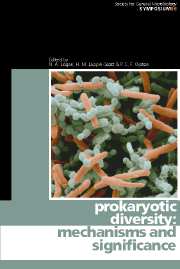Book contents
- Frontmatter
- Contents
- Contributors
- Editors' Preface
- Microbial diversity in the era of genomics
- Patterns in prokaryotic biodiversity
- A putative RNA-interference-based immune system in prokaryotes: the epitome of prokaryotic genomic diversity
- The significance of prokaryote diversity in the human gastrointestinal tract
- The genetics of phenotypic innovation
- Minimal genomes required for life
- Evolution of the core of genes
- Biogeographical diversity of archaeal viruses
- Is there a link between Chlamydia and heart disease?
- Unculturable oral bacteria
- Comparative genomics – what do such studies tell us about the emergence and spread of key pathogens?
- Spread of genomic islands between clinical and environmental strains
- Evolving gene clusters in soil bacteria
- Unusual micro-organisms from unusual habitats: hypersaline environments
- Genomic islands and evolution of catabolic pathways
- Horizontal gene transfer and its role in the emergence of new phenotypes
- Index
Patterns in prokaryotic biodiversity
Published online by Cambridge University Press: 06 July 2010
- Frontmatter
- Contents
- Contributors
- Editors' Preface
- Microbial diversity in the era of genomics
- Patterns in prokaryotic biodiversity
- A putative RNA-interference-based immune system in prokaryotes: the epitome of prokaryotic genomic diversity
- The significance of prokaryote diversity in the human gastrointestinal tract
- The genetics of phenotypic innovation
- Minimal genomes required for life
- Evolution of the core of genes
- Biogeographical diversity of archaeal viruses
- Is there a link between Chlamydia and heart disease?
- Unculturable oral bacteria
- Comparative genomics – what do such studies tell us about the emergence and spread of key pathogens?
- Spread of genomic islands between clinical and environmental strains
- Evolving gene clusters in soil bacteria
- Unusual micro-organisms from unusual habitats: hypersaline environments
- Genomic islands and evolution of catabolic pathways
- Horizontal gene transfer and its role in the emergence of new phenotypes
- Index
Summary
INTRODUCTION
The variety of life has long fascinated biologists. One of the most intriguing aspects of this diversity is that it is distributed heterogeneously across the Earth, with some places harbouring a myriad of different forms of life and others supporting depauperate communities. There appear to be regularities in this heterogeneous distribution, patterns in the distribution of life's diversity, for many well-studied macro-organisms. Until recently, relatively few patterns in the distribution of microbial life have been documented, in large part because microbiologists and ecologists have just recently begun to look for such patterns.
Diversity patterns have played a major role in the development of the science of general ecology (i.e. theoretical, plant, animal and ecosystem ecology). It is reasonable to assume that the study of diversity patterns could play a similar role in the development of microbial ecology. Where should one look for such patterns in microbial biodiversity? Given our limited knowledge of the distribution of microbial diversity, it is reasonable to start by looking for patterns in microbial diversity that are commonly observed for macro-organisms. In this chapter, we begin by discussing how diversity in general and microbial diversity in particular is estimated. We then describe a number of diversity patterns commonly observed for macro-organisms and review recent attempts to document such patterns in microbial diversity. We focus primarily on prokaryotic micro-organisms; however, patterns in the diversity of eukaryotic microbes have also been documented (e.g. Green et al., 2004; Smith et al., 2005).
- Type
- Chapter
- Information
- Prokaryotic DiversityMechanisms and Significance, pp. 19 - 38Publisher: Cambridge University PressPrint publication year: 2006
- 1
- Cited by



